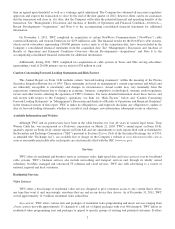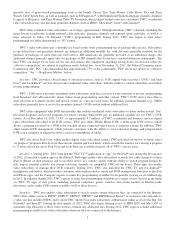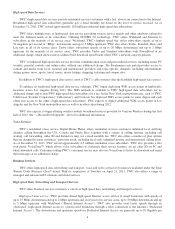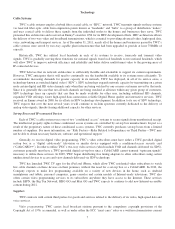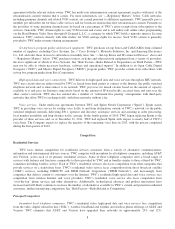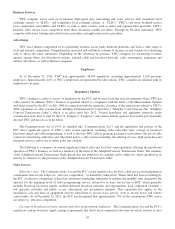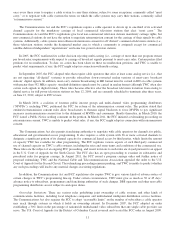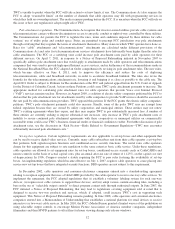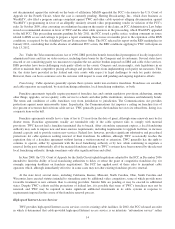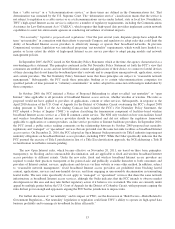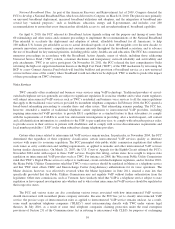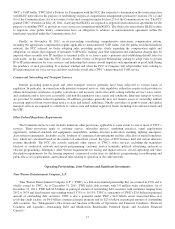Time Warner Cable 2011 Annual Report Download - page 20
Download and view the complete annual report
Please find page 20 of the 2011 Time Warner Cable annual report below. You can navigate through the pages in the report by either clicking on the pages listed below, or by using the keyword search tool below to find specific information within the annual report.TWC is unable to predict when the FCC will take action to set new limits, if any. The Communications Act also requires the
FCC to adopt “reasonable limits” on the number of channels that cable operators may fill with programming services in
which they hold an ownership interest. The matter remains pending before the FCC. It is uncertain when the FCC will rule on
this issue or how any regulation it adopts might affect TWC.
Pole attachment regulation. The Communications Act requires that investor-owned utilities provide cable systems and
telecommunications carriers with non-discriminatory access to any pole, conduit or right-of-way controlled by those utilities.
The Communications Act permits the FCC to regulate the rates, terms and conditions imposed by these utilities for cable
systems’ use of utility poles and conduit space. States are permitted to preempt FCC jurisdiction over pole attachments
through certifying that they regulate the terms of attachments themselves. Many states in which TWC operates have done so.
Rates for “cable” attachments and “telecommunications” attachments are calculated under different provisions of the
Communications Act and rates for telecommunications services attachments have historically been higher than the rates for
cable attachments. The FCC or a certifying state could increase pole attachment rates paid by cable operators for their
different services. On April 7, 2011, in response to a Notice of Proposed Rulemaking initiated in November 2007 to
specifically address pole attachment rates that would apply to attachments made by cable operators and telecommunications
companies that were used to provide high-speed Internet access services, and in furtherance of the recommendations made in
the National Broadband Plan, the FCC adopted an Order comprehensively revising its pole attachment rules. The new rules,
which became effective on June 8, 2011, seek to improve the efficiency and reduce the costs of deploying
telecommunications, cable and broadband networks, in order to accelerate broadband buildout. The rules also revise the
formula for the telecommunications attachment rate, lowering it and bringing it as close as possible to the cable rate. The
April 2011 Order is subject to Petitions for Reconsideration at the FCC and judicial appeal before the U.S. Court of Appeals
for the District of Columbia Circuit. Action on these Petitions could cause TWC’s pole attachment payments to increase. The
appropriate method for calculating pole attachment rates for cable operators that provide Voice over Internet Protocol
(“VoIP”) services remains unclear. However, in August 2009, a coalition of electric utility companies petitioned the FCC to
declare that the pole attachment rate for attachments used by cable companies to provide VoIP services should be assessed at
the rate paid by telecommunications providers. TWC opposed this petition. If the FCC grants the electric utility companies’
petitions, TWC’s pole attachment payments could also increase. Finally, some of the poles TWC uses are exempt from
federal regulation because they are owned by utility cooperatives and municipal entities. These entities may not renew
TWC’s existing agreements when they expire, and they may require TWC to pay substantially increased fees. A number of
these entities are currently seeking to impose substantial rate increases. Any increase in TWC’s pole attachment rates or
inability to secure continued pole attachment agreements with these cooperatives or municipal utilities on commercially
reasonable terms could cause TWC’s business, financial results or financial condition to suffer. For further discussion of pole
attachment rates, see the discussion in “Risk Factors—Risks Related to Government Regulation—TWC may encounter
substantially increased pole attachment costs.”
Set-top box regulation. Certain regulatory requirements are also applicable to set-top boxes and other equipment that
can be used to receive digital video services. Currently, many cable subscribers rent from their cable operator a set-top box
that performs both signal-reception functions and conditional-access security functions. The rental rates cable operators
charge for this equipment are subject to rate regulation to the same extent as basic cable service. Under these regulations,
cable operators are allowed to set equipment rates for set-top boxes, conditional-access security cards or CableCARDs and
remote controls on the basis of actual capital costs, plus an annual after-tax rate of return of 11.25%, on the capital cost (net
of depreciation). In 1996, Congress enacted a statute requiring the FCC to pass rules fostering the availability of set-top
boxes. An implementing regulation, which became effective on July 1, 2007, requires cable operators to cease placing into
service new set-top boxes that have integrated security functions. DBS operators are not subject to this requirement.
In December 2002, cable operators and consumer-electronics companies entered into a standard-setting agreement
relating to reception equipment that uses a CableCARD provided by the cable operator to receive one-way cable services. To
implement the agreement, the FCC adopted regulations that (i) establish a voluntary labeling system for such one-way
devices; (ii) require most cable systems to support these devices; and (iii) adopt various content-encoding rules, including a
ban on the use of “selectable output controls” to direct program content only through authorized outputs. In June 2007, the
FCC initiated a Notice of Proposed Rulemaking that may lead to regulations covering equipment sold at retail that is
designed to receive two-way products and services, which, if adopted, could increase TWC’s cost in supporting such
equipment. This Notice of Proposed Rulemaking remains pending. In June 2008, cable operators and consumer-electronics
companies entered into a Memorandum of Understanding that establishes a national platform for retail devices to receive
interactive (or two-way) cable services. In May 2010, the FCC’s Media Bureau granted a limited waiver of the prohibition on
using selectable output controls to encourage Motion Picture Association of America member companies, independent
filmmakers and their MVPD partners to offer films for home viewing during early release windows.
12


